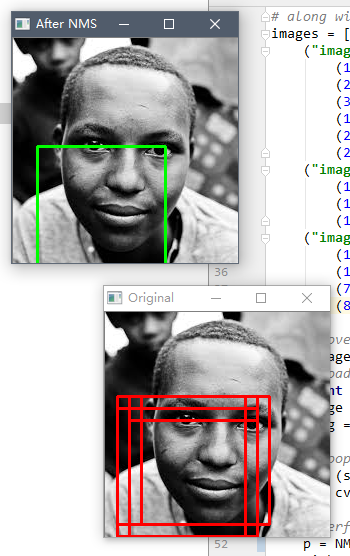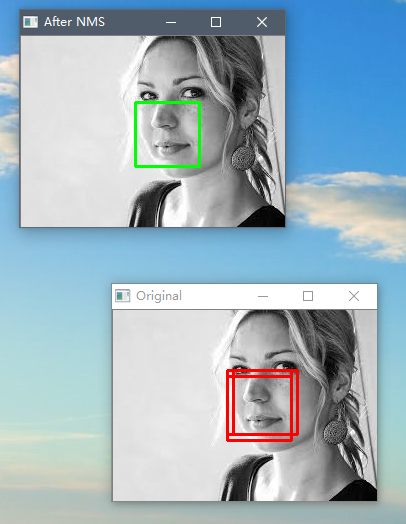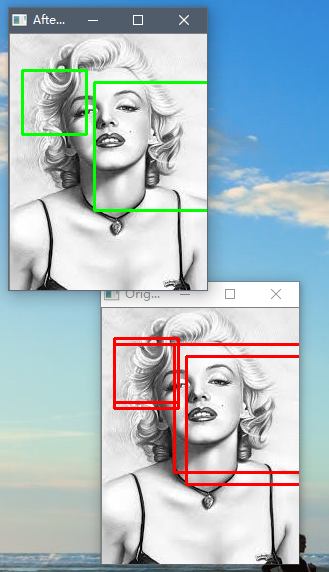一、NMS实现代码
# http://www.pyimagesearch.com/2015/02/16/faster-non-maximum-suppression-python/ import numpy as np class NMSuppression(object): def __init__(self, bbs, overlapThreshold = 0.45): self.bbs = bbs self.overlapThreshold = overlapThreshold def _check_empty(self): # return an empty list, if there are no boxes if len(self.bbs) == 0: return [] else: return self.bbs def _check_dtype(self): # if the bounding boxes integers, convert them to floats (divisions) if self.bbs.dtype.kind == "i": self.bbs = self.bbs.astype("float") return self.bbs def bb_coordinates(self): # get the coordinates of the bounding boxes x1 = self.bbs[:, 0] y1 = self.bbs[:, 1] x2 = self.bbs[:, 2] y2 = self.bbs[:, 3] return x1, y1, x2, y2 def bb_area(self): # compute the area of the bounding boxes x1, y1, x2, y2 = self.bb_coordinates() area = (x2 - x1 + 1) * (y2 - y1 + 1) return area def calc_ovarlap(self, x1, y1, x2, y2, idxs, last, i, area): # find the largest (x, y) coordinates for the start of # the bounding box and the smallest (x, y) coordinates # for the end of the bounding box xx1 = np.maximum(x1[i], x1[idxs[:last]]) yy1 = np.maximum(y1[i], y1[idxs[:last]]) xx2 = np.minimum(x2[i], x2[idxs[:last]]) yy2 = np.minimum(y2[i], y2[idxs[:last]]) # compute the width and height of the bounding box w = np.maximum(0, xx2 - xx1 + 1) h = np.maximum(0, yy2 - yy1 + 1) # compute the ratio of overlap overlap = (w * h) / area[idxs[:last]] return overlap def slow_suppress(self): self._check_empty() self._check_dtype() # initialize the list of picked indexes picked = [] x1, y1, x2, y2 = self.bb_coordinates() # compute the area of the bounding boxes area = self.bb_area() # sort the bounding boxes by the bottom-right y-coordinate of the bounding box idxs = np.argsort(y2) # keep looping while some indexes still remain in the indexes list while len(idxs) > 0: # grab the last index in the indexes list, add the index # value to the list of picked indexes, then initialize # the suppression list (i.e. indexes that will be deleted) # using the last index last = len(idxs) - 1 i = idxs[last] picked.append(i) suppress = [last] # loop over all indexes in the indexes list for pos in xrange(0, last): # grab the current index j = idxs[pos] # find the largest (x, y) coordinates for the start of # the bounding box and the smallest (x, y) coordinates # for the end of the bounding box xx1 = max(x1[i], x1[j]) yy1 = max(y1[i], y1[j]) xx2 = min(x2[i], x2[j]) yy2 = min(y2[i], y2[j]) # compute the width and height of the bounding box w = max(0, xx2 - xx1 + 1) h = max(0, yy2 - yy1 + 1) # compute the ratio of overlap between the computed # bounding box and the bounding box in the area list overlap = float(w * h) / area[j] # if there is sufficient overlap, suppress the # current bounding box if overlap > self.overlapThreshold: suppress.append(pos) # delete all indexes from the index list that are in the # suppression list idxs = np.delete(idxs, suppress) # return only the bounding boxes that were picked return self.bbs[picked] def fast_suppress(self): self._check_empty() self._check_dtype() # initialize the list of picked indexes picked = [] x1, y1, x2, y2 = self.bb_coordinates() # compute the area of the bounding boxes area = self.bb_area() # sort the bounding boxes by the bottom-right y-coordinate of the bounding box idxs = np.argsort(y2) # keep looping while some indexes still remain in the indexes list while len(idxs) > 0: # take the last index in the indexes list and add the # index value to the list of picked indexes last = len(idxs) - 1 i = idxs[last] picked.append(i) overlap = self.calc_ovarlap(x1, y1, x2, y2, idxs, last, i, area) # delete all indexes from the index list that have idxs = np.delete(idxs, np.concatenate(([last], np.where(overlap > self.overlapThreshold)[0]))) # return only the bounding boxes that were picked using the # integer data type return self.bbs[picked].astype("int")
二、调用测试
#taken from: http://www.pyimagesearch.com/2014/11/17/non-maximum-suppression-object-detection-python """ Project parts (taken from the tutorial above): 1. Sampling positive images 2. Sampling negative images 3. Training a Linear SVM 4. Performing hard-negative mining 5. Re-training your Linear SVM using the hard-negative samples 6. Evaluating your classifier on your test dataset, utilizing non-maximum suppression to ignore redundant, overlapping bounding boxes The sample images in this project are taken from the web (labeled as: no licensing needed for non-comertial use). """ from nm_suppression import NMSuppression import numpy as np import cv2 # construct a list containing the images that will be examined # along with their respective bounding boxes images = [ ("images/africa.jpeg", np.array([ (12, 84, 140, 212), (24, 84, 152, 212), (36, 84, 164, 212), (12, 96, 140, 224), (24, 96, 152, 224), (24, 108, 152, 236)])), ("images/girl.jpeg", np.array([ (114, 60, 178, 124), (120, 60, 184, 124), (114, 66, 178, 130)])), ("images/monroe.jpeg", np.array([ (12, 30, 76, 94), (12, 36, 76, 100), (72, 36, 200, 164), (84, 48, 212, 176)]))] # loop over the images for (imagePath, boundingBoxes) in images: # load the image and clone it print "[x] %d initial bounding boxes" % (len(boundingBoxes)) image = cv2.imread(imagePath) orig = image.copy() # loop over the bounding boxes for each image and draw them for (startX, startY, endX, endY) in boundingBoxes: cv2.rectangle(orig, (startX, startY), (endX, endY), (0, 0, 255), 2) # perform non-maximum suppression on the bounding boxes p = NMSuppression(bbs=boundingBoxes, overlapThreshold=0.5) pick = p.fast_suppress() print "[x] after applying non-maximum, %d bounding boxes" % (len(pick)) # loop over the picked bounding boxes and draw them for (startX, startY, endX, endY) in pick: cv2.rectangle(image, (startX, startY), (endX, endY), (0, 255, 0), 2) # display the images cv2.imshow("Original", orig) cv2.imshow("After NMS", image) cv2.waitKey(0)
三、效果


